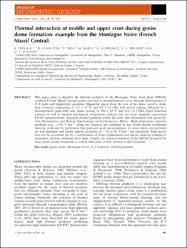Thermal interaction of middle and upper crust during gneiss dome formation: example from the Montagne Noire (French Massif Central)
Abstract
This paper aims to decipher the thermal evolution of the Montagne Noire Axial Zone (MNAZ, southern French Massif Central) gneiss core and its metasedimentary cover through determination of P-T paths and temperature gradients. Migmatitic gneiss from the core of the dome record a clockwise evolution culminating at 725 +/- 25 degrees C and 0.8 +/- 0.1 GPa with partial melting, followed by a decompression path with only minor cooling to 690 +/- 25 degrees C and 0.4 +/- 0.1 GPa. Field structural analyses as well as detailed petrological observations indicate that the cover sequence experienced LP-HT metamorphism. Apparent thermal gradients within the cover were determined with garnet-biotite thermometry and Raman Spectroscopy on Carbonaceous Matter. High-temperature apparent gradients (e.g. similar to 530 degrees C km(-1) along one transect) are explained by late brittle-ductile extensional shearing evidenced by phyllonites that post-date peak metamorphism. In areas where normal faults are less abundant and closely spaced, gradients of similar to 20 to 50 degrees C km(-1) are calculated. These gradients can be accounted for by a combination of dome emplacement and ductile shearing (collapse of isotherms), without additional heat input. Finally, the thermal evolution of the MNAZ is typical for many gneiss domes worldwide as well as with other LP-HT terranes in the Variscides.


















